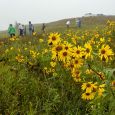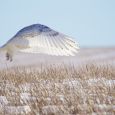The Gift of South Dakota
Subscriptions to South Dakota Magazine make great gifts!
Subscribe today — 1 year (6 issues) is just $29!
The Hidewood
Deuel County's Hidden Woods
 |
| Keith Diekman and his lab Trixie explore the oak forest where Dakota Indians hid after the Minnesota uprising. |
The Hidewood Valley of Deuel County derived its name from Dakota Indians who called it the Hidden Woods.
In the summer of 1862, some of the Indians involved in bloody conflicts with white settlers in Minnesota fled across the border and hid for a time in the valley.
Some of the same slow-growing oaks that sheltered the Dakota still stand, along with their offspring, and it would still be possible to lose oneself in the thick growth that populates some of the 30-mile stretch of hills.
Deuel County lies on the east slope of the Coteau des Prairies. The highest point in the region is on a farm field east of Castlewood that overlooks the Minnesota River valley. Indians marked the site with rocks and used it to spot water. Today it is marked with a tin government sign.
Hidden among the occasional woods and grassy hills is other modern evidence of century-old stories that speak to the difficulties of life here for both man and beast.
The forest once grew so thick "you needed headlights to drive through in the daytime." — Hidewood old-timer
Many of the stories are buried by time and grass, but some old-timers know the Hidewood and its secrets. Floyd and Gladys Haug farmed in the Hidewood country during their younger years.
Floyd grew up on a farm in the valley. When we visited him in 1999, he told us wolves still howled at night when he was a child. Not far from the old Haug family farm, buffalo rings can still be found in a pasture. The circular indentations were formed perhaps 150 years ago or more when wolves threatened buffalo herds.
"The cows would form a circle and put their calves in the center," Floyd said. "Then as the wolves came closer, the cows would circle around and around, protecting their calves."
The rings always turn green before the rest of the prairie in springtime, probably because the cows left manure in their excitement, and their indented path collects moisture which speeds the grass.
Not far from the buffalo rings — but on the opposite side of Interstate 29, which cuts through the Hidewood — two nearly forgotten graves lie high on a pasture hill.
Floyd discovered the graves when he rented the land in the 1950s. "I was fixing the fence on May 10 and I saw two perfect rectangles of blue flag flowers."
 |
| Floyd Haug pulls grass away from the blue flag flowers that still mark the graves of a homesteader's wife and daughter. The flowers had bloomed several weeks before our arrival. |
He suspected that the flowers were planted to mark a grave site and when he visited the landowner, Ed Koppman, his hunch was confirmed.
From research done by the Haugs and the late Clear Lake farmer-historian Henry Wells, it seems the land was homesteaded by a Norwegian settler named Per Gustav Erikson and his wife, Ida Mary. Little else is known about the Eriksons.
Wells did discover some additional details from the register of deeds in Deuel County and other historical records. "It is a story that has no beginning and no end," he told us. The Eriksons came from Norway, stopping first in Wisconsin.
Wells figured they came by train to Gary and probably used their savings to buy a horse and wagon to drive to their new home in Section Eight of Hidewood Township. They settled on a hill overlooking a valley. "It probably looked to them like a peninsula in their native Norway."
In the early l880s they had a baby daughter. But during the harsh winter of 1885-86, a diphtheria outbreak struck the territory and both Ida Mary and the daughter died. Because the snow was so deep and the ground so frozen, their bodies were placed in two wooden boxes built by a neighbor.
The grieving young settler kept the rough-hewn coffins in a shed until spring, when he dug two graves just to the south of his house and buried them above the Hidewood Valley. He probably had no money for a permanent marker, but he planted blue flag flowers — a cousin to the iris — in the overturned soil.
That same year, he sold his claim for $300 to Peter Dahl. Wells said nothing else is known for certain. "Did he go a few miles or did he follow the trail left by others to Oregon? I see him as a man with lowered head passing into the midst of time, ever searching for a new life."
Blue flags bloom for a brief time in early May, and when Floyd Haug happened upon them 60 years after they were planted he was intrigued by the fact that they had survived the elements.
“They survived the Dirty Thirties when grass wouldn’t even grow,” he marveled. “They survived the badgers and the gophers and the cows that have grazed on those hills.”
 |
| The Hidewood forest ends abruptly at the edge of the flat prairie. |
Now, almost 130 years later, the flowers still mark the simple grave site. Prairie grasses have infiltrated the flowers, but the blue flags still grow thick and in the obvious rectangular shape of a grave. They have outlasted many pioneer grave markers.
Only a few people now know where the Erikson graves can be found. But other gravesites in the Hidewood are even more forgotten. Some belong to Indians, and others to early settlers.
Floyd said the landscape didn’t change dramatically in his lifetime — and he knew this country as well as anyone. He was born here in 1918, and passed away in nearby Castlewood in 2010. As a youngster, he earned 50–75 cents a day for carrying the mail by horseback and sleigh in winter to neighboring farms.
Many farmsteads were once situated in the Hidewood Valley. It offered good grass, water and protection from the wind. Farms have been thinned out by weather and economics.
But some remain. One of the surviving farm families is the Diekmans, who came in 1946. Keith Diekman’s land includes some of the oak forest where Sioux Indians took refuge during the 1862 uprising.
A visit to the forest is all the research needed to understand why they came. It is a lush oasis on a nearly treeless prairie, rich with tall grass, shade, wildlife and water.
"In a winter storm, you can go down there and it will be as nice and pleasant as can be," says Diekman. "It is a good place to winter cattle."
 |
| Foliage from burr oak, a rarity on the Coteau des Prairies, but a dominant tree in the Hidewood forest. |
Along with old burr oak trees, the forest is dense with native grasses, chokecherry bushes and ash. Diekman said areas of the forest once grew so thick that old-timers said, "you needed headlights to drive through in the daytime."
That was the density desired by the Dakota Indians. According to Kenneth Garley's book, The Sioux Uprising of 1862, the blood began to flow after a trivial incident in which one Indian called another a coward because he had cautioned his friends to not steal a white family's eggs.
One misstep led to another, and before long the Indians entered a farmyard and shot five members of two families. Eventually, the conflict spread dramatically and over 450 settlers and soldiers were killed. Thirty-eight Indians were executed for their crimes.
Little is known of the party of Indians that hid out in the valley, but their presence gave the range of hills its name and a colorful history still talked about today.
Robert Amerson, who grew up on a Hidewood valley farm in the 1930s, brought more attention to the hills recently when he published childhood memoirs called From the Hidewood. His grandfather came to Deuel County as a homesteader in 1876.
In the book, Amerson refers to the Hidewood as "an in-between country" that was too rough for quality farming and too far east for customary ranching.
He said the Hidewood farmers felt a remoteness, even from their nearest neighbors who often tilled better land and lived closer to the town and cities. But he says the families were good and honest folk.
"The Hidewood community taught me that you can trust people and expect them to help you. Out in the country, you can still assume your neighbor — or even a stranger — is a decent person, at least until proved otherwise."
The Amersons are now gone from the valley, along with most of their neighbors. Over 9,000 people lived in Deuel County in the 1920's but the number has been dropping ever since.
Still, improvements can be seen in the rural infrastructure. For example, a good gravel road winds its way past the Diekman farm, past abandoned barns and the gurgling Hidewood Creek that meanders through the valley. The creek eventually empties into the Big Sioux near Estelline, crossing into the southeast corner of Hamlin County.
Even though the road was constructed in 1955, it is still called The New Road by locals. The name is one more reminder of how life has a way of staying the same in the Hidewood.
Editor’s Note: This story is revised from the September/October 1999 issue of South Dakota Magazine. To order a copy or to subscribe, call 800-456-5117.










Comments
Thanks!
Joan B. Sacrison
Executive Director
DANN G. WILSON II
S. CAROLINA
Respectfully,
Margaret